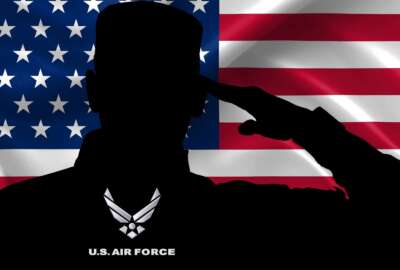

The Air Force plans to extend the capabilities of its future fighter jets with semi-autonomous drones built with commercially available parts.
An Air Force plan to acquire a new type of semi-autonomous drones follows an emerging pattern of buying items that are already at least partially available commercially and modifying them for Defense Department needs. The collaborative combat aircraft (CCA) will fly alongside fighter jets as a robot wingman that extends the jets’ capabilities without requiring another pilot.
The drones are part of an effort to buy cheaper aircraft and field them faster using components already available through commercial vendors. The Air Force plans to buy 1,000 to 2,000 modular, unmanned drones to accompany its next generation of fighter planes.
“What we’re seeing is that there’s a lot of off-the-shelf technology that can be applied to these platforms. There are dozens of companies that already have these platforms they’ve developed that would be ready to go tomorrow. It’s not like you have to come up with a set of requirements,” said Rep. Rob Wittman (R-Va.) at the Atlantic Council Nexus 23 Symposium May 17.
The drones would solve several problems for the Air Force, including a shortage of both aircraft and pilots. The common design framework would help guard against vendor lock because no single producer would have all the design information. The large quantities of drones also lend themselves to using more producers.
“These will be semi-autonomous, but the things that they’re able to do are game changers. They will allow our end aircraft to do orders of magnitude more than they could do with a single pilot behind the stick. They are force multipliers in that these aircraft will operate in concert with manned aircraft,” said Wittman, chairman of the House Armed Services Committee’s tactical air and land forces subcommittee.
Although the program still has several years of research and testing ahead of it, the acquisition model seeks to avoid the escalating costs and timeframes of larger aircraft programs. The drones will have a design which allows for simpler production that could employ multiple vendors. Producing them on a large scale should also create a lower and more predictable cost. The drones are estimated to cost around $20 million each. While not disposable, that would be considerably cheaper than manned fighter jets, Wittman said.
“When you start talking numbers like that, larger stocks will make more sense,” Air Force Secretary Frank Kendall said at a Defense Writers Group media roundtable on May 22.
The Air Force has yet to set a time frame for a request for proposal for the drones. Kendall said the department wants to have the design fully-vetted with testing and integration before the drones go into production.
“There’s great opportunities here for innovation, and to push the state of the art. We’re trying to work with industry to incentivize industry to get as much capability as possible,” Kendall said.
The Air Force plans to spend about $6 billion in research, development, test and evaluation funds on CCAs between 2024 and 2028. The drones could be outfitted for different capabilities but share common design elements. Part of keeping the program affordable will be the ability to use equipment from existing aircraft that can be used interchangeably with CCAs.
“With modular designs with specific subsystems for specific missions, with some basic capability that you can complement and use in combinations right across different platforms, you can get some really interesting and affordable results,” Kendall said. “One of the core requirements for CCAs is that they’re affordable. And you know, we got a unit cost on the order of a fraction of an F-35.”
Lawmakers and Air Force officials have said the idea of mix-and-match modular design could well be a model for other programs. If the CCAs prove as versatile as planned, the plan could be used in future acquisitions. Wittman said the Army and Marine Corps are looking into acquiring similar types of drones. Kendall declined to give specific details about acquisition strategy for the platform, but said the Air Force was talking to multiple venders and planned to use as many as possible.
“It creates a lot of opportunities. Some of our tactics experts started looking at it and they got very excited about the possibilities that this will bring to the table. We’re still figuring all that out. But the idea is to push it as far as we think we can with reasonable risk,” Kendall said.
Copyright © 2025 Federal News Network. All rights reserved. This website is not intended for users located within the European Economic Area.
Alexandra Lohr, a former staff member, covered the Defense Department for Federal News Network until September 2023.

